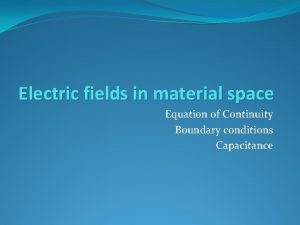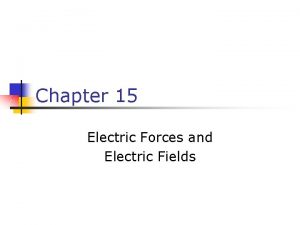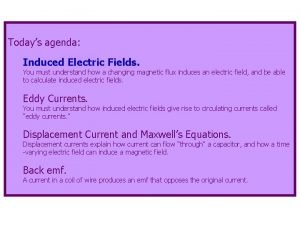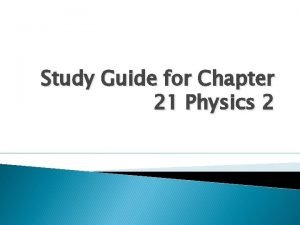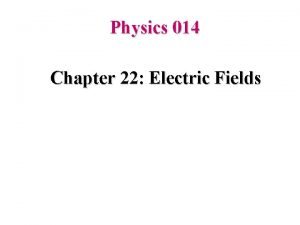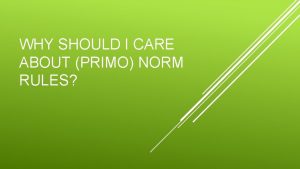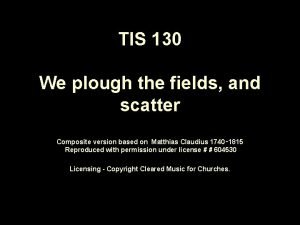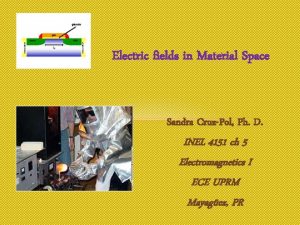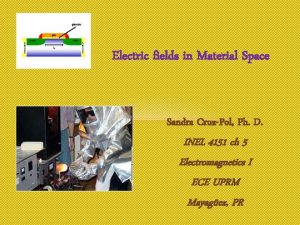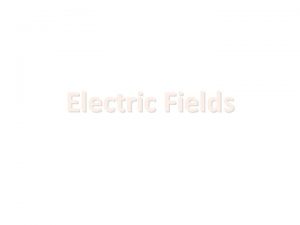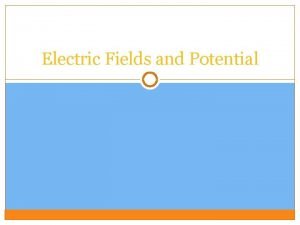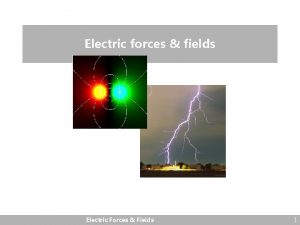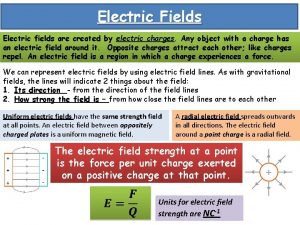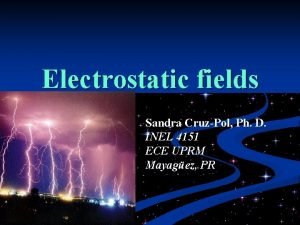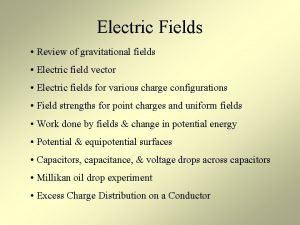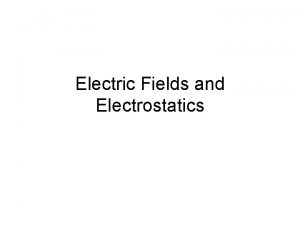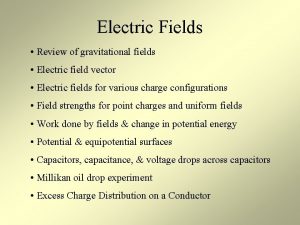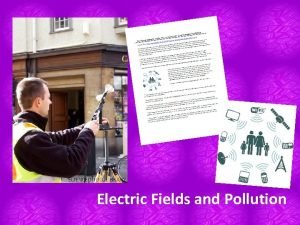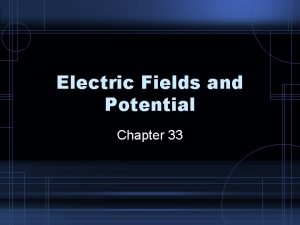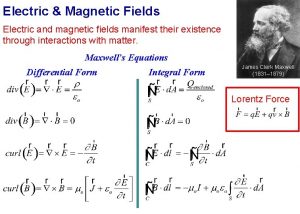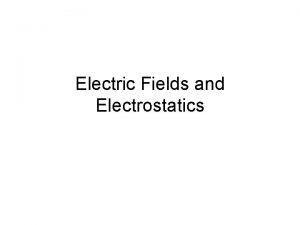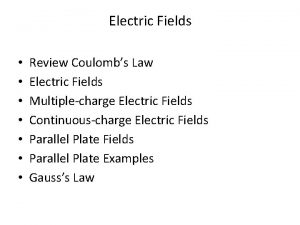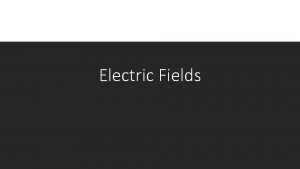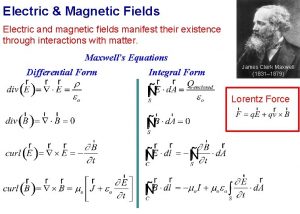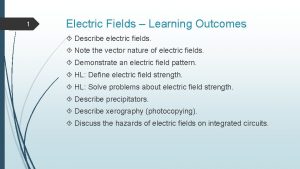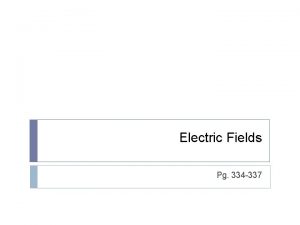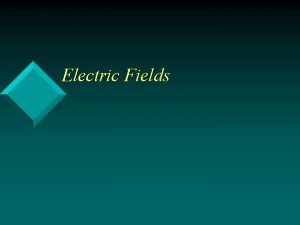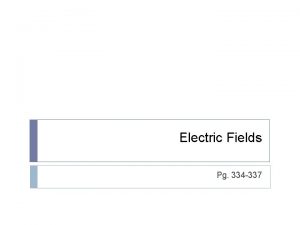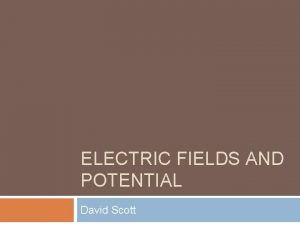Electric fields in Material Space Sandra CruzPol Ph





![Current Units: Amperes [A] Definition: is the electric charge passing through an area per Current Units: Amperes [A] Definition: is the electric charge passing through an area per](https://slidetodoc.com/presentation_image_h2/b03ad764db6a5c1ddf1adcffd65d92a6/image-6.jpg)

![u Current in a filament o Convection current, [A] Dl DS rv o Convection u Current in a filament o Convection current, [A] Dl DS rv o Convection](https://slidetodoc.com/presentation_image_h2/b03ad764db6a5c1ddf1adcffd65d92a6/image-8.jpg)















![What is Relaxation Time? [s] What is Relaxation Time? [s]](https://slidetodoc.com/presentation_image_h2/b03ad764db6a5c1ddf1adcffd65d92a6/image-24.jpg)
![What is Relaxation Time? [s] Is the time it takes a charge placed in What is Relaxation Time? [s] Is the time it takes a charge placed in](https://slidetodoc.com/presentation_image_h2/b03ad764db6a5c1ddf1adcffd65d92a6/image-25.jpg)











- Slides: 36

Electric fields in Material Space Sandra Cruz-Pol, Ph. D. INEL 4151 ch 5 Electromagnetics I ECE UPRM Mayagüez, PR

Last Chapter: free space NOW: different materials

Some applications o o superconductors High permittivity dielectrics Transistors Electromagnets

We will study Electric charges: o Conductors or Insulators n Depends on Frequency and Temperature… o Boundary conditions Conductors Insulators (metals) (dielectrics) Semiconductors

Material @ 20 o. C Low frequency Silver Conductivity (S/m) Copper 5. 8 x 107 Gold 4. 1 x 107 Aluminum 3. 5 x 107 Carbon 3 x 104 Sea water 4 Silicon 4. 4 x 10 -4 Pure water 10 -4 Dry Earth 10 -5 Glass, Quartz 10 -12, 10 -17 Appendix B 6. 1 x 107 Conductorshave many free electrons available. Colder metals conduct better. (superconductivity) semiconductor Insulators at most lower frequencies.
![Current Units Amperes A Definition is the electric charge passing through an area per Current Units: Amperes [A] Definition: is the electric charge passing through an area per](https://slidetodoc.com/presentation_image_h2/b03ad764db6a5c1ddf1adcffd65d92a6/image-6.jpg)
Current Units: Amperes [A] Definition: is the electric charge passing through an area per unit time. Current Density, [A/m 2] Is the current thru a perpendicular surface:

Depending on how I is produced: There are different types of currents. o Convection- I flows thru isolator: liquid, gas, vacuum. n Doesn’t involve conductors, n doesn’t satisfies Ohm’s Law o Conduction- flows thru a conductor o Displacement (ch 9)
![u Current in a filament o Convection current A Dl DS rv o Convection u Current in a filament o Convection current, [A] Dl DS rv o Convection](https://slidetodoc.com/presentation_image_h2/b03ad764db6a5c1ddf1adcffd65d92a6/image-8.jpg)
u Current in a filament o Convection current, [A] Dl DS rv o Convection density, A/m 2

Conduction Current o Requires free electrons, it’s inside conductor. o Suffers collisions, drifts from atom to atom Newton’s Law o Conduction current density is: where rv=ne

A Perfect conductor Has many charges that are free to move. o Therefore it can’t have an E field inside which would not let the charges move freely. o So, inside a conductor Charges move to the surface to make E=0

Resistance o If you force a Voltage across a conductor: o Then E is not 0 o The e encounter resistance to move E I S l V +- rc=1/s= resistivity of the material

Power in Watts =Rate of change of energy or force x velocity Joule’s Law

PE 5. 1 Find the current thru the cylindrical surface o For the current density

PE 5. 2 In a Van de Graaff generator, w=0. 1 m, u=10 m/s and the leakage paths have resistance 1014 W. o If the belt carries charge 0. 5 m. C/m 2, find the potential difference between the dome and the base. w= width of the belt u= speed of the belt

PE 5. 3 The free charge density in Cu is 1. 81 x 1010 C/m 3. . o For a current density of 8 x 106 A/m 2, find the electric field intensity and the drift velocity.

Polarization in dielectrics The effect of polarization on a dielectric is to have a surface bound charge of: and leave within it an accumulation of volume bound charge: rps and rpv are the polarization (bounded) surface and volume charge densities

Permittivity and Strength o Not really a constant!

Dielectric properties o Linear = e doesn’t change with E o Isotropic= e doesn’t change with direction o Homogeneous= e doesn’t change from point to point. Coulomb’s Law for any material:

PE 5. 6. A parallel plate capacitor with plate separation of 2 mm has a 1 k. V voltage applied to its plane. o If the space between its plates is filled with polystyrene, find E and P.

PE 5. 7. In a dielectric material, Ex= 5 V/m and o Find:

Continuity Equation o Charge is conserved.

For steady currents: o Change= output current –input current = 0

Substituting in: where Tr=e/s is called the Relaxation time
![What is Relaxation Time s What is Relaxation Time? [s]](https://slidetodoc.com/presentation_image_h2/b03ad764db6a5c1ddf1adcffd65d92a6/image-24.jpg)
What is Relaxation Time? [s]
![What is Relaxation Time s Is the time it takes a charge placed in What is Relaxation Time? [s] Is the time it takes a charge placed in](https://slidetodoc.com/presentation_image_h2/b03ad764db6a5c1ddf1adcffd65d92a6/image-25.jpg)
What is Relaxation Time? [s] Is the time it takes a charge placed in the interior of a material to drop to e-1 of its initial value. o Find Tr for silver o Find Tr for rubber:

Boundary Conditions o We have two materials o How the fields behave @ interface?

Boundary Conditions o We have two materials o How do the fields behave @ interface? We look at the tangential and the perpendicular component of the fields.

Cases for Boundary Conditions: 1. Dielectric- dielectric 2. Conductor- Dielectric 3. Conductor-Free Space

Dielectric-dielectric B. C. o Consider the figure below: E 1 n E 1 q 1 e 1 E 2 n e 2 a b E 1 t Dh E 2 t d c Dw

D 2 n Dielectric-dielectric B. C. o Consider the figure below: D 1 n D 1 DS D 1 t D 2 t e 1 e 2 r. S Dh

Dielectric-Dielectric B. C. In summary: E 1 n D 2 n E 1 q 1 E 1 t D 2 t e 1 e 2 Dh

Conductor-dielectric B. C. o Consider the figure below: En e 1 q 1 c d Et dielectric conductor E s 2=∞ E 2=0 Dh a Dw b

Conductor-dielectric B. C. o Consider the figure below: En e 1 DS q 1 Et dielectric conductor E s 2=∞ E 2=0 r. S Dh

Conductor-Free Space B. C. o Consider the figure below: En eo q 1 c d Et Free space conductor E s 2=∞ E 2=0 Dh a Dw b

PE 5. 9 A homogeneous dielectric (er=2. 5) fills region 1 (x<0), while region 2(x>0) is free space. o Find

5. 29 Lightning strikes a dielectric sphere of radius 2 -mm for which er=2. 5, s=5 x 10 -6 S/m and deposits uniformly a charge of 1 C. o Determine the initial volume charge density and the volume charge density 2 ms later. Answer: 29. 84 KC/m 3, 18. 98 k. C/m 3
 Red fields to green fields
Red fields to green fields Electric field in material space
Electric field in material space Electric forces and fields concept review
Electric forces and fields concept review Chapter 16: electric forces and fields answers
Chapter 16: electric forces and fields answers Electric fields quiz
Electric fields quiz Chapter 33 conceptual physics
Chapter 33 conceptual physics Electric fields
Electric fields Electric fields
Electric fields Induced electric field in a solenoid
Induced electric field in a solenoid Physics 2 study guide
Physics 2 study guide Electric currents and magnetic fields
Electric currents and magnetic fields Electric currents and magnetic fields
Electric currents and magnetic fields Electric field for a disk
Electric field for a disk Electric field to energy
Electric field to energy Joules per coloumb
Joules per coloumb Electric potential energy definition
Electric potential energy definition Electric field from electric potential
Electric field from electric potential A suitable electric pump in an electric circuit is a
A suitable electric pump in an electric circuit is a Chapter 21 electric charge and electric field
Chapter 21 electric charge and electric field Chapter 21 electric charge and electric field
Chapter 21 electric charge and electric field Units for coulombs
Units for coulombs Chapter 21 electric charge and electric field
Chapter 21 electric charge and electric field Electric charges and electric forces lesson outline
Electric charges and electric forces lesson outline Geometric symbol
Geometric symbol Idle time meaning in cost accounting
Idle time meaning in cost accounting Culture includes
Culture includes The knowledge language values customs and material objects
The knowledge language values customs and material objects Example of material culture
Example of material culture Useful but harmful materials at home
Useful but harmful materials at home Cartesian space trajectory planning
Cartesian space trajectory planning Space junk the space age began
Space junk the space age began Camera space to world space
Camera space to world space Cartesian space vs joint space
Cartesian space vs joint space World space computer
World space computer Norm rule fields
Norm rule fields How many fields in computer science
How many fields in computer science We plough the fields and scatter modern version
We plough the fields and scatter modern version

